When to Switch from a Harness to a Seatbelt
It’s no coincidence that the term “booster seat age” gets a crazy number of searches every month. Parents want to know. The answer is: it’s more than just age that matters. Come along…
“When do I switch from the 5-point harness to a seatbelt (high back booster) car seat?”
– It depends…
Criteria for Switching
It’s never a bad idea to keep your child in a 5-pt harness for as long as possible, but if they are jonesing to graduate to a seatbelt, there are two deciding factors here: maturity and height. This is typically at least 5 years old, 6-7 if you have a squirmy worm, and perhaps older if your child has special needs. Most experts agree: the minimum booster seat age is 5.
Note that you cannot use a belt positioning booster seat with a seat belt if you have a lap belt (only), you MUST have a shoulder belt to use this type of child safety seat.
Criteria to see if your kiddo is the correct age for a booster seat (seat belt) ~
1. Your child needs the maturity to sit properly in a safety belt (i.e., they won’t try to wriggle out of it, sit improperly, lean forward in their seat or (godforbid!), unbuckle themselves while driving).
2. They have to be tall enough for the safety belt to hit him in the right place (i.e., in the middle of the shoulder with the belt actually in contact with the shoulder). The shoulder belt positioner (or “guide”) on a belt positioning booster seat brings the seat belt down to a lower position to hit your child in the right spot.
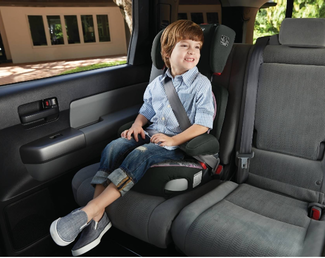
Once these two things are checked off the list, then you can decide that it’s time to remove the harness and let him use the seatbelt.
The big perk to letting your child use the regular ol’ adult seatbelt, of course, is that s/he can buckle and unbuckle himself — whaaat!? This makes the job of getting everyone into and out of the car seat (especially if you have multiple kids) SO MUCH EASIER. Oh, the joy!!!!
Proper Seat Belt Positioning
Whatever you do, please don’t make the mistake of switching to a backless booster too early. I see too many five year olds (and sometimes three and four year olds!) riding around in tiny backless booster seats and it’s completely inappropriate for their size. After you graduate from a rear facing seat, don’t skip over the forward facing car seat (harnessed) phase!
Most kids I see who are prematurely using backless booster seats have the shoulder belt hitting them at the neck, or even in the face (below!): not good. See photo below.
The shoulder belt should land in the middle of the shoulder, go across the collar bone and cross the chest at their nice, sturdy sternum. Trust me, you don’t want your child’s neck to be what is taking the bulk of impact in an accident.
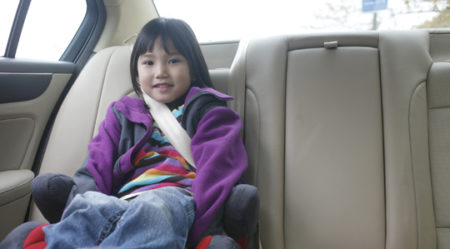
Photo courtesy of the National Highway Traffic Safety Administration
There is one critical safety element for seats used in booster mode, and that is the shoulder belt guide MUST be wide and roomy enough to allow the seat belt to easily retract after being buckled.
If the safety belt can’t retract and become snug, the seat is basically unusable (you’ll see what I mean when you start using it). That said, all of the seats here have good shoulder belt guides (some of the cheaper ones do not).
Note that once you switch to seat belt (booster) mode, you can (and should) install the seat with LATCH, simply just to keep it in place if unoccupied during a crash. This will keep the seat from becoming a projectile if your kid isn’t in it.
The Infamous Top Tether
The top tether (or “tether strap”) is a big point of confusion for most people, but I can make it very simple for you…you should absolutely use the top tether in a forward facing seat, no matter if it’s installed using lower anchors (LATCH) or if it’s installed using the seat belt.
I call it the “top tether” because it comes out of the top of the seat (see below).
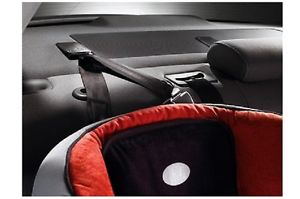
If your car was made on or after 2003, you will have both lower anchor points (the ones that are in your seats) and tether anchors (for that top tether strap) in your vehicle.
So where does it go?
If you have a sedan, those anchors are directly behind the seat (as shown above).
If you have a third row or a hatchback, those anchors are usually on the floor of the back area or on the back of the seat itself, as shown below.
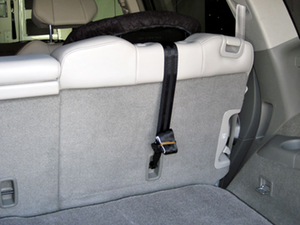
Please consult your car’s owner’s manual if you can’t find them.
Why it’s important to use that tether
Using the top tether (vs. not using it) will dramatically reduce the amount of forward force (or “head excursion”) in a collision, no matter which type of child restraint you are using. The illustration below shows the difference in head excursion in a child whose seat is tethered vs. one that is not.
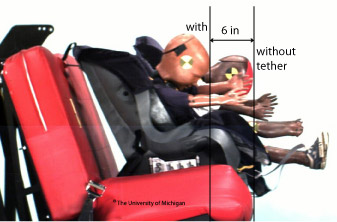
To boil it down without getting too technical: the child who is not tethered is at a much higher risk for head injury and spinal cord damage – ’nuff said.
Ok, enough scary crash test dummy stuff trust me, guys, I could go on for DAYS!).
There are four highly rated manufacturers of harness-to-booster combination seats: Graco, Evenflo Chicco and Britax. Here are our Favorite Forward Facing Seats